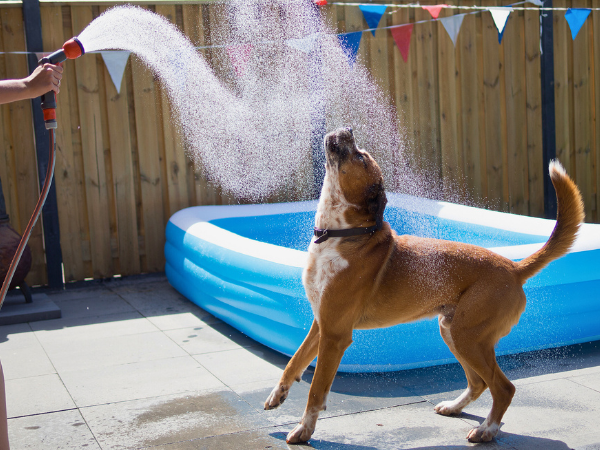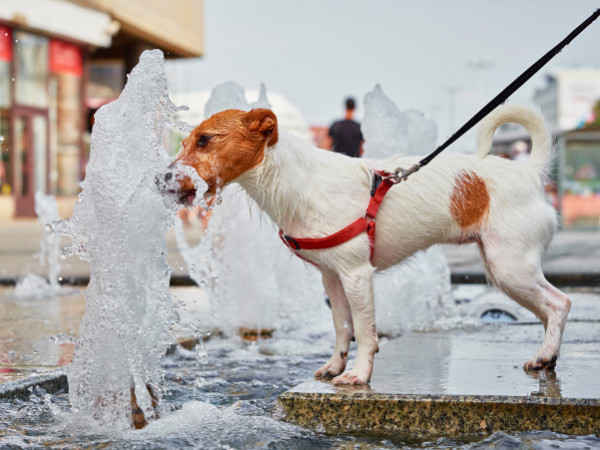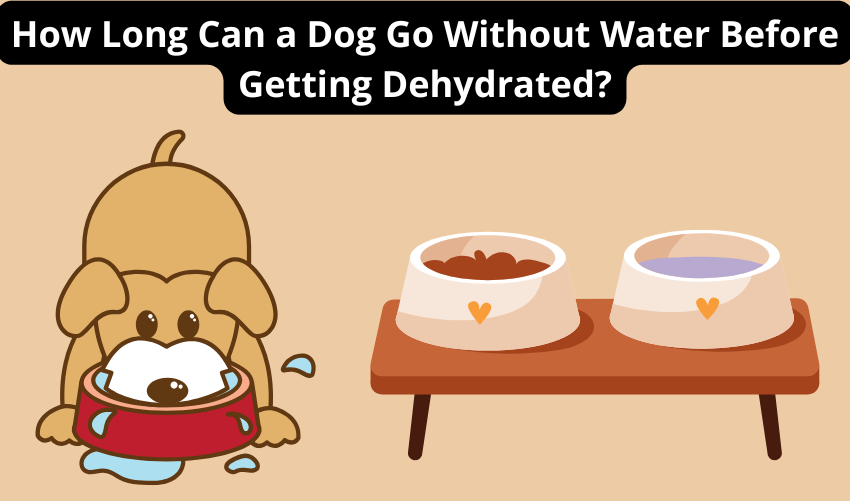Several factors influence how quickly a dog can become dehydrated, including age, health, size, and activity level.
Knowing the signs of dehydration can help you act quickly. This information is vital for all dog owners, especially during hot summer days or long trips.
Understanding Your Dog’s Hydration Needs
Water is vital for their well-being. Dogs can become dehydrated quickly without enough water. This dehydration can lead to serious health problems.
How Much Water Dogs Typically Need Daily
Dogs generally require ½ to 1 ounce of water per pound of body weight per day. This means a 50-pound dog needs between 25 to 50 ounces of water daily. Several factors affect this amount.
Here are some general guidelines to consider:
- Small dogs: 10-20 ounces per day
- Medium dogs: 20-40 ounces per day
- Large dogs: 40-80 ounces per day
Factors like activity level and diet can change these numbers. For example, a dog on a dry food diet may need more water than one on a wet food diet.
Factors That Affect Water Consumption
Several factors affect how much water your dog needs. Each factor plays a role in their hydration levels.
- Activity Level: Active dogs need more water. Playtime and exercise increase their water needs.
- Diet Type: Dry food requires more water. Wet food has higher moisture content.
- Weather: Hot weather increases water needs. Dogs lose more water through panting.
- Underlying Health Issues: Conditions like diabetes or kidney disease may require more attention to water intake.
Observe your dog for signs of dehydration. Symptoms include dry gums, lethargy, and excessive panting. Always provide fresh water and encourage drinking, especially on warm days.

How Long Can A Dog Go Without Water Safely?
Most dogs can only last about 2–3 days without water. After that, dehydration sets in, causing serious health risks. It’s crucial to know the signs of dehydration and how to prevent it.
Average Time Limit Before Dehydration Sets In
Most dogs can only last about 2–3 days without water. This timeframe may vary based on several factors:
- Size of the dog
- Age of the dog
- Activity level
- Environmental conditions
Smaller dogs may become dehydrated faster than larger breeds. Puppies and older dogs are also at higher risk.
Here is a quick reference table for dehydration time limits:
| Dog Size | Time Without Water |
|---|---|
| Small (up to 20 lbs) | 1-2 days |
| Medium (20-50 lbs) | 2-3 days |
| Large (50 lbs and over) | 3 days |
After 24 hours without water, your dog may show early signs of dehydration. Immediate attention is necessary to prevent serious health issues.
Signs Of Dehydration In Dogs
Recognizing the signs of dehydration is vital for your dog’s health. Common symptoms include:
- Dry nose: A dry or cracked nose can indicate dehydration.
- Lethargy: Lack of energy or unusual tiredness is a red flag.
- Sunken eyes: Eyes that appear sunken can signal dehydration.
- Loss of skin elasticity: Pinch the skin on the back of the neck. If it doesn’t return quickly, your dog is likely dehydrated.
- Thick saliva: Saliva that feels sticky can also mean dehydration.
Be aware of these signs. If you notice any symptoms, offer your dog water immediately. Consult a veterinarian if your dog does not drink or shows severe symptoms.
The Dangers Of Prolonged Dehydration
Understanding the dangers of dehydration helps dog owners prevent these risks. Let’s explore the effects of dehydration on your dog’s health.
Short-term Effects On Health
In the short term, dehydration can cause various health problems for dogs. Even a few hours without water can lead to noticeable symptoms. Here are some of the most common short-term effects:
- Dry mouth: A lack of saliva makes the mouth dry.
- Decreased urine output: Less frequent urination indicates dehydration.
- Loss of skin elasticity: Skin may not spring back when pinched.
- Confusion: Dogs may seem disoriented or confused.
- Elevated heart rate: A faster heartbeat can occur due to fluid loss.
These symptoms can escalate quickly. Observing your dog closely during hot weather or after exercise is crucial. Early intervention can prevent more severe problems.

Long-term And Life-threatening Risks
Chronic dehydration poses serious risks to your dog’s life. Extended periods without water can lead to critical health issues. Here are some long-term effects:
- Organ failure: Dehydration can cause major organs to shut down.
- Shock: A drop in blood volume can lead to shock, which is life-threatening.
- Death if untreated: Severe dehydration can result in death without prompt care.
It is essential to provide fresh water at all times. Monitoring your dog’s water intake can help avoid these serious risks. Always seek veterinary help if you suspect your dog is dehydrated.
How Long Can A Dog Go Without Water And Food?
Hydration is vital for health. Dogs can quickly get dehydrated without water. Food is also important, but dogs can survive longer without it. Knowing these limits helps ensure your pet’s well-being.
Without Water And Food: A Much Shorter Window
Dogs can survive longer without food (5–7 days) than without water (2–3 days). This difference highlights the importance of hydration. Without water, a dog’s health can decline rapidly. Here are some key points to consider:
- Water keeps organs functioning.
- Dehydration can cause serious health issues.
- Signs of dehydration include dry gums and lethargy.
Food can take longer to affect a dog’s health. A lack of food can lead to weakness and weight loss. But dogs often have fat reserves that help them survive longer without meals.
When To Worry And Call A Vet
Recognizing signs of dehydration and hunger is essential. Dogs may show specific symptoms that require immediate attention. Key signs to watch for include:
- Dry mouth and gums
- Sunken eyes
- Loss of skin elasticity
- Excessive panting
- Weakness or lethargy
These symptoms indicate your dog may be dehydrated or in distress. If you notice any of these signs, take action quickly. A vet can assess your dog’s condition and provide necessary treatment.
Why A Dog Might Stop Drinking Water
Understanding why a dog might stop drinking water is essential for pet owners. Identifying the reasons behind a dog’s decreased water intake is key to keeping them safe.
Common Causes Of Reduced Thirst
Many factors can cause a dog to drink less water. Some are related to health, while others are environmental or behavioral.
- Illness: Dogs may avoid water if they feel unwell.
- Pain: Any discomfort can make a dog less interested in drinking.
- Dental Issues: Problems with teeth or gums can cause pain while drinking.
- Dirty Water Bowls: Dogs may refuse to drink from unclean bowls.
- Unfamiliar Environments: New places can make dogs anxious, reducing their thirst.
Pay attention to your dog’s health. If they stop drinking water, consult a veterinarian.
Behavioral And Environmental Triggers
Behavior and surroundings also affect a dog’s desire for water. Stress can play a significant role.
- Stress: Changes in routine can make dogs anxious.
- Travel: Going to new places may confuse or frighten them.
- New Routines: Switching daily habits can disrupt their drinking habits.
- Diet Changes: A new diet may alter their thirst levels.
Here are some tips to encourage your dog to drink more water:
- Ensure clean, fresh water is always available.
- Change water bowls regularly to keep them clean.
- Try different types of bowls to see what they prefer.
- Consider adding wet food to their diet for extra hydration.
Understanding these triggers helps keep your dog hydrated. Always monitor their water intake and behavior.
Encouraging Your Dog To Drink More Water
Simple methods can make drinking water more appealing. Let’s explore ways to keep your furry friend well-hydrated.
Simple Tricks To Keep Them Hydrated
Keeping your dog hydrated can be easy with a few simple tricks. Here are some effective methods:
- Fresh Water: Always provide fresh, clean water. Change the water daily to keep it appealing.
- Clean Bowls: Regularly wash your dog’s water bowl. A clean bowl encourages them to drink more.
- Moisture-Rich Foods: Incorporate wet dog food into their diet. This adds extra hydration through their meals.
Another fun way is to make drinking a game. Use a bowl that is fun to drink from. You can even add ice cubes to the water. Many dogs enjoy playing with ice.
Products That Help Promote Hydration
Many products can help your dog stay hydrated. Consider these options:
- Pet Water Fountains: These fountains keep water fresh and circulating. Dogs love to drink from them.
- Electrolyte-Enhanced Treats: Offer treats that have added electrolytes. These can help replenish lost fluids.
- Wet Dog Food: Choose high-quality wet food. It provides moisture and is often more palatable.
These products can make a big difference. Look for options your dog enjoys. Keeping water fun and appealing can encourage them to drink more.


